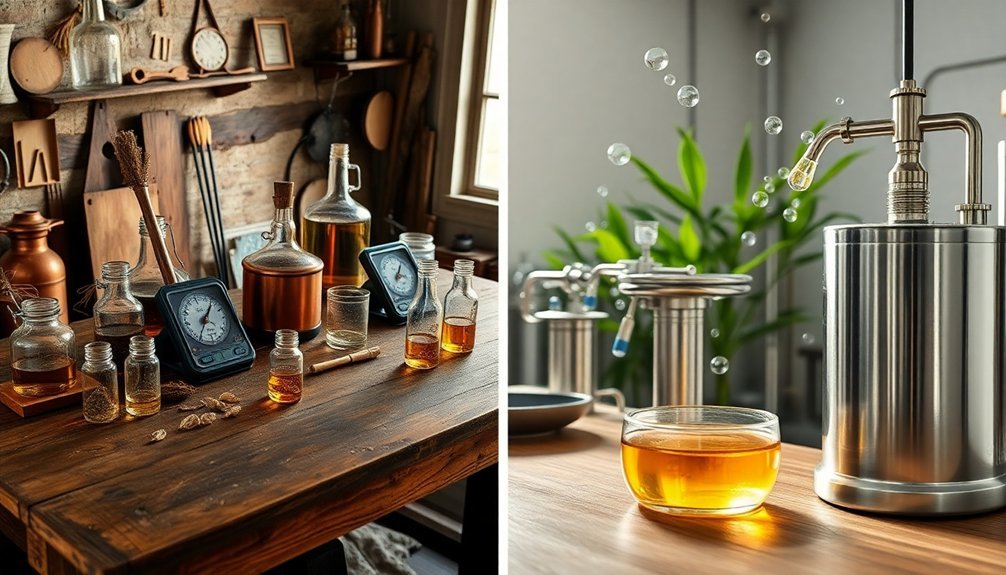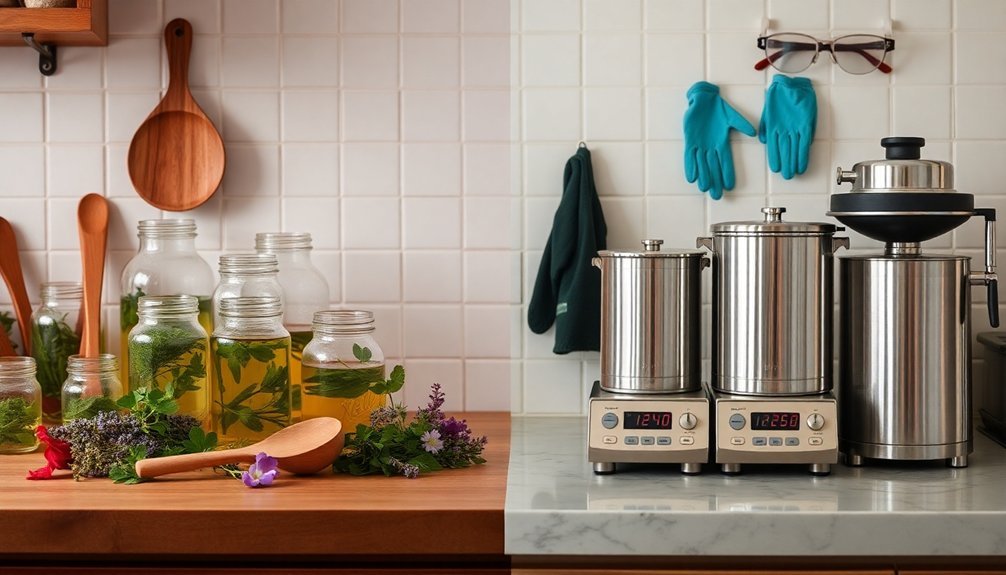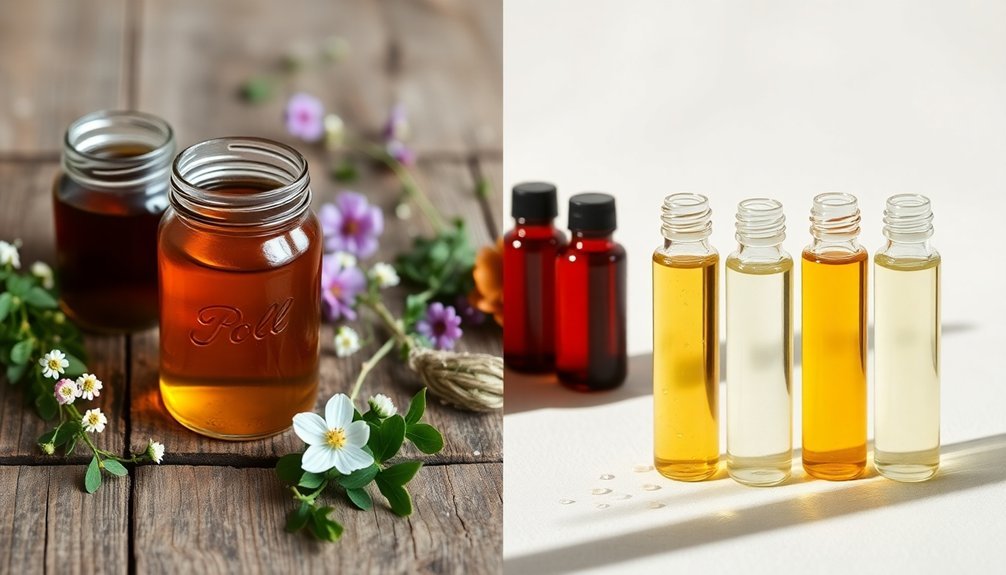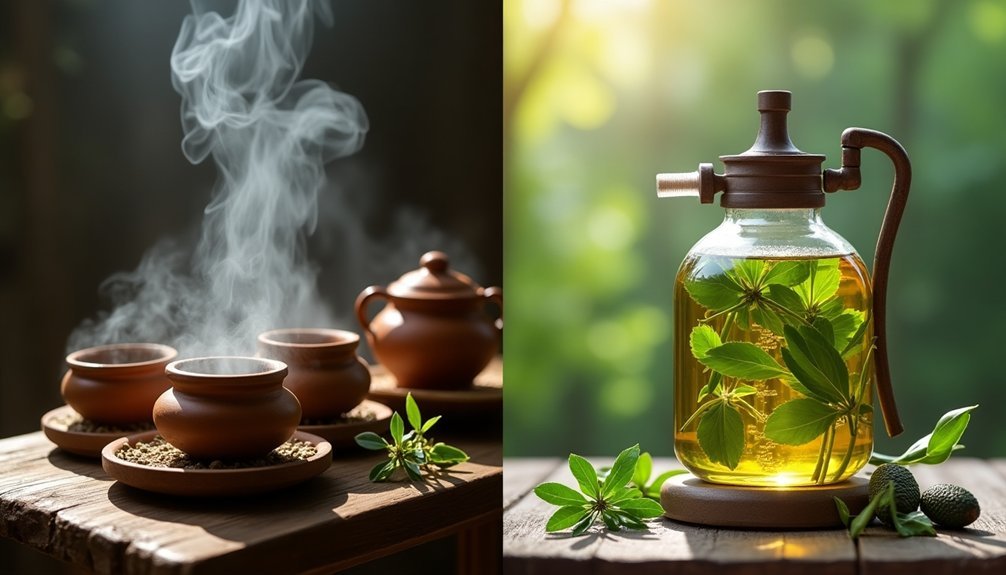Traditional botanical oil extraction relies on simple pressing and steam distillation, while modern methods employ advanced technologies like supercritical CO2 and solvent-based extraction. You'll find that traditional techniques are more accessible for home use but labor-intensive, offering smaller yields. Modern methods provide higher efficiency and purity but require specialized equipment and training. Whether you're crafting essential oils or infused botanicals, understanding these distinct approaches will enhance your extraction success.
Understanding the Evolution of Botanical Oil Extraction

Throughout history, the extraction of botanical oils has evolved from simple pressing techniques to sophisticated modern methods that maximize both efficiency and quality.
You'll find traditional methods like cold pressing, which involves mechanically squeezing oils from fruit peels, and enfleurage, an ancient technique that captures delicate flower essences using absorbent fats.
As technology advanced, solvent extraction emerged, using chemicals to draw oils from plant materials. The process often involves using ethanol or methanol to penetrate plant structures and release essential compounds.
Today, you've got access to cutting-edge techniques like CO2 extraction and solvent-free microwave methods.
These modern approaches offer significant advantages – they're more environmentally friendly, produce higher quality oils, and preserve more of the plant's natural compounds.
The shift from traditional to modern extraction methods reflects our growing understanding of botanical properties and the demand for purer, more potent oils.
Steam Distillation: The Time-Tested Method
You'll discover that steam distillation stands as the gold standard for extracting essential oils, where steam gently releases volatile compounds from plant materials while preserving their natural properties.
Through careful temperature control in the distillation process, you can prevent thermal damage to sensitive botanical compounds and guarantee the highest quality extraction.
The process not only yields pure essential oils but also produces beneficial hydrosols, making it a uniquely efficient method for capturing both oil-soluble and water-soluble plant compounds. Steam distillation achieves superior results by maintaining phyto compounds' native state, unlike direct heat methods that can cause chemical alterations.
Essential Oil Extraction Process
Steam distillation stands as one of the most reliable methods for extracting essential oils from botanical materials.
When you're extracting oils, you'll heat water to create steam, which passes through your plant materials placed in a biomass flask. As the steam rises, it releases volatile compounds from the botanicals.
You'll find that the steam and oils travel through a water-cooled condenser, where they return to liquid form. The condensed mixture then separates naturally, as oil and water don't mix. You can collect the essential oil from the surface, while the hydrosol settles below.
While it's an efficient process that preserves oil quality and works well for most plants, you'll need to be cautious with delicate flowers, as the heat can degrade their aromatic compounds. The entire process typically takes between 1 to 8 hours depending on the type of plant material being distilled.
It's also time-consuming but remains cost-effective for both small and commercial operations.
Temperature Control Fundamentals
When working with steam distillation, precise temperature control forms the foundation of successful essential oil extraction.
You'll need to maintain temperatures around 100°C at atmospheric pressure, which is below the boiling points of individual constituents. This lower temperature preserves the delicate molecular structures of your essential oils while effectively vaporizing them.
Your steam source, typically introduced at the column's bottom, travels upward through the plant material, softening cellular structures and carrying the vaporized oils to the condensation chamber.
As you monitor the process, you'll find that steam reduces the oil components' boiling points, preventing thermal decomposition.
In the condensation chamber, the vapor mixture cools and separates naturally due to density differences, with the essential oil forming a distinct layer above the therapeutic hydrosol.
Hydrosol Production Benefits
A treasured byproduct of steam distillation, hydrosols offer unique therapeutic benefits distinct from their essential oil counterparts. When steam passes through plant material, it captures volatile compounds, creating a water-based solution rich in therapeutic properties.
| Property | Essential Oils | Hydrosols |
|---|---|---|
| Concentration | Highly concentrated | Gentle, diluted |
| Usage | Requires dilution | Ready to use |
| Application | Limited direct use | Versatile, direct use |
| Cost | More expensive | More affordable |
You'll find hydrosols particularly valuable for skincare, aromatherapy, and culinary applications. Their gentle nature makes them ideal for facial toners and rejuvenating mists, while their therapeutic compounds can help reduce stress and promote relaxation. Since they're already water-based, you won't need additional dilution, making them convenient for immediate use in your wellness routine.
Cold Pressing: Preserving Natural Essence
To preserve the delicate essence of botanical materials, cold pressing stands out as one of the purest extraction methods available.
You'll find this process particularly effective for citrus fruits and seeds, where mechanical force extracts oils while maintaining their natural properties.
When you're looking for superior quality oils, cold pressing delivers exceptional results.
The method preserves heat-sensitive compounds and essential nutrients because it doesn't use high temperatures or chemical solvents.
You'll notice the difference in the vibrant aromas and flavors of cold-pressed oils compared to those extracted through other methods.
While you might pay more for cold-pressed oils due to lower yields, you're getting enhanced bioavailability and antioxidant properties.
The process guarantees you receive pure, nutrient-rich oils that retain their natural color and aroma, making them ideal for both therapeutic and culinary applications.
Solvent-Based Techniques in Modern Practice

Modern solvent-based extraction represents three distinct advantages: higher yields, faster processing, and lower operational costs compared to traditional methods.
You'll find hexane as the most common solvent in commercial operations due to its superior oil solubility and efficient recovery rates.
If you're operating a facility, you'll need to carefully consider temperature control – higher temperatures speed up the process but can compromise oil quality.
Today's continuous extractors, particularly those using collets (porous pellets), offer you better efficiency than batch systems.
While hexane remains dominant, you might want to explore newer alternatives like ethanol or SC-CO2.
These options address growing environmental and safety concerns, though they'll require higher initial investment and may result in lower oil yields.
The Rise of Supercritical CO2 Technology
Building upon traditional solvent methods, supercritical CO2 extraction has emerged as a revolutionary approach in botanical oil processing. You'll achieve this state by heating CO2 above 87.98°F and pressurizing it beyond 1,071 psi, creating a powerful yet gentle extraction medium.
What makes this technology stand out is its impressive efficiency and extract quality. You can fine-tune the process by adjusting temperature and pressure, achieving up to 95% pure compounds while preserving delicate terpenes and cannabinoids.
The high diffusivity and low viscosity of supercritical CO2 guarantee deep penetration into plant material, maximizing yield.
You won't find hazardous residues in the final product, as this environmentally friendly method leaves virtually no impurities.
When stored properly under refrigeration, your extracts will maintain their quality for up to five years.
Ethanol Extraction: Efficiency Meets Quality

While supercritical CO2 leads in technological advancement, ethanol extraction remains a cornerstone of botanical processing due to its remarkable versatility and safety profile.
You'll find that ethanol's unique ability to dissolve both polar and nonpolar compounds makes it exceptionally effective for capturing a wide spectrum of plant compounds, from essential oils to flavonoids.
When you're working with ethanol extraction, you'll benefit from its FDA-recognized safety status and quick evaporation properties.
For ideal results, you'll want to use dried, finely ground plant materials with ethanol concentrations between 70% and 95%.
The resulting extracts offer enhanced bioavailability, meaning your body can absorb the active compounds more effectively.
Store your finished extract in a dark glass bottle in a cool place to maintain its potency.
Cold Infusion: Gentle Extraction for Delicate Herbs
You'll find cold infusion particularly effective for preserving heat-sensitive plant compounds while maintaining ideal control over the extraction process.
The method's success depends on your careful attention to temperature stability, keeping your herbs away from direct sunlight and maintaining a consistent room temperature between 65-75°F.
When starting your infusion, follow a 1:2 herb-to-oil ratio for dried materials or 1:3 for fresh herbs to guarantee proper extraction without risking spoilage.
Slow Cold Infusion Benefits
When crafting botanical oils with delicate herbs, cold infusion stands out as the gentlest and most effective extraction method.
You'll preserve the volatile compounds and essential oils that often get lost with heat exposure, making it perfect for sensitive herbs like basil, mint, and St. John's Wort.
This slow, patient process allows for maximum therapeutic benefits while protecting the subtle flavors and medicinal properties of your botanicals.
- You'll achieve a more potent final product through gradual extraction over 2-6 weeks.
- Your herbs' delicate compounds remain intact, as they're never exposed to damaging heat.
- You'll maintain the full therapeutic properties of both the oil and herbs, resulting in a superior infusion.
The method's simplicity and effectiveness make it ideal for preserving the integrity of your chosen botanicals.
Optimal Temperature Control Methods
Maintaining proper temperature control during cold infusion requires careful attention to detail and consistent monitoring. You'll need to store your infusion in a cool, dark place where temperatures remain stable, away from heat sources and direct sunlight.
To achieve ideal results, you should use clean, sanitized glass jars and verify your herbs are completely dry before starting. Fill the jar halfway with your chosen herbs, then cover them entirely with oil. You'll want to select oils that remain liquid at room temperature.
During the 2-6 week infusion period, shake the mixture regularly to keep herbs submerged and promote extraction.
For maximum shelf life, store your finished infusion in the refrigerator for up to six months, or at room temperature for three months. Always use clean, labeled bottles for storage.
Herb-to-Oil Ratio Guidelines
Successful cold infusion depends heavily on achieving the right balance between herbs and oil.
You'll want to make sure your herbs are chopped to tea-leaf size and completely covered with oil, leaving just under a quarter inch of oil above the plant material. For best extraction, select liquid oils that remain pourable at room temperature, such as olive or grapeseed oil, and use only dry herbs to prevent spoilage.
For the best results, follow these essential ratios:
- Fill your jar 1/2 to 2/3 full with crumbled herbs to allow proper oil coverage
- Add enough oil to submerge herbs completely, plus 1/4 inch above
- Leave about 1 inch of headspace in the jar for gentle agitation during the 2-6 week infusion period
Warm Infusion: Accelerated Oil Production
Through the warm infusion method, you'll achieve faster oil production while maximizing the extraction of beneficial plant compounds. You'll need to maintain temperatures between 110-120°F using indirect heat sources like crockpots or double boilers to preserve the oil's properties.
This technique works exceptionally well for tough plant materials such as roots, barks, and seeds, as the heat helps break down their rigid cell walls. You'll want to heat your mixture over medium-low heat until it reaches about 140°F, then continue for another 5 minutes.
Monitor the temperature carefully, as overheating can damage the oil's quality. Unlike cold infusion, you can complete this process in as little as 30 minutes to 12 hours, making it an efficient choice for producing high-quality infused oils with concentrated plant compounds.
Safety Protocols for Home Oil Extraction

Safe oil extraction at home requires careful attention to multiple safety measures that protect both you and your workspace.
You'll need to work in a well-ventilated area while wearing appropriate protective gear like gloves and eyewear. Keep your oils stored in dark glass bottles, tightly sealed, and labeled with dates in a cool, dry place away from sunlight.
- Never use undiluted oils directly on your skin – always mix with a carrier oil and perform a patch test first.
- Keep all heat sources away from your extraction area to prevent ignition of volatile compounds.
- If you're pregnant, nursing, or have medical conditions, consult your healthcare provider before working with essential oils.
Remember to avoid sun exposure after using photosensitive oils, and never allow oils to contact your eyes or mucous membranes.
Equipment Selection and Maintenance
When you're selecting oil infusion equipment, you'll need essential components like heat-resistant containers, precise temperature controls, and proper filtration systems that match your intended extraction method.
You must maintain strict cleaning and sterilization protocols by thoroughly washing all equipment after each use and sanitizing with food-grade cleaners to prevent cross-contamination.
Following a regular preventive maintenance schedule will help you identify potential issues early, extend your equipment's lifespan, and guarantee consistent, high-quality infusions.
Essential Equipment Components
Selecting the right equipment for botanical oil infusions can greatly impact your results and overall experience. Modern infusion machines offer wireless control, customizable settings, and user-friendly interfaces that make the process effortless.
You'll find high-quality materials like stainless steel and ceramic-coated reservoirs that guarantee durability and consistent results.
- Set your desired parameters with variable temperature controls up to 250°F, adjustable time settings up to 12 hours, and customizable oil-to-herb ratios.
- Access multiple pre-programmed cycles for specific infusions, including butter, oil, and tincture options.
- Utilize the two-stage filtration system with silicone funnels and filter bags for precise straining.
The best machines feature dishwasher-safe components, making cleanup a breeze.
With safety features like oven mitts and clear user manuals, you'll be creating professional-grade infusions in no time.
Cleaning and Sterilization Protocols
Maintaining pristine equipment goes hand-in-hand with creating high-quality botanical infusions.
You'll need to implement a thorough cleaning protocol using formulated detergents rather than ethanol, as they're safer and more cost-effective. For ideal results, use alkaline detergents at 60°C for 10 minutes, followed by a purified water rinse.
Consider investing in a Clean-in-Place (CIP) system, which will standardize your cleaning process and reduce manual labor.
When cleaning, you'll want to pay special attention to surface materials and guarantee proper detergent concentration – typically 1-3% for alkaline solutions.
Don't forget to conduct regular visual inspections and use coupon testing to verify cleaning effectiveness.
Preventive Maintenance Schedule
A robust preventive maintenance schedule starts with proper equipment selection and importance analysis.
You'll need to identify which pieces of equipment are most essential to your oil infusion process and understand the potential impact of their failure. Consider the value each piece brings to your operation rather than just its purchase cost.
- Create a maintenance calendar based on manufacturer recommendations, adjusting intervals according to your specific usage patterns and environmental conditions.
- Prioritize tasks that directly impact oil quality and safety, such as cleaning extraction vessels, calibrating temperature controllers, and maintaining filtration systems.
- Assign clear responsibilities to your team members, providing detailed checklists for each maintenance task and establishing a documentation system to track completed work.
Remember to regularly review and update your maintenance schedule based on equipment performance and any recurring issues you identify.
Optimal Storage Methods for Infused Oils
Proper storage of botanical infused oils requires three essential elements: the right container, ideal location, and careful monitoring.
You'll need to use sterilized, dark-colored glass containers with tight-fitting lids to protect your oils from light degradation and contamination. Amber dropper bottles work best for daily use, while larger jars are perfect for bulk storage.
Store your infused oils in a cool, dark place like a cupboard or pantry, away from direct sunlight to prevent oxidation.
While room temperature storage works for up to three months, refrigeration can greatly extend shelf life.
Don't forget to add a few drops of vitamin E oil as a preservative and label each container with the date and contents.
Check your oils regularly for signs of spoilage, such as mold or unusual odors.
Quality Assessment of Extracted Oils

When evaluating the quality of your extracted botanical oils, you'll need to employ both scientific analysis and sensory evaluation techniques.
Chemical composition analysis through gas chromatography and mass spectrometry will reveal the presence of essential compounds and potential contaminants. You'll also want to check oxidation levels through peroxide value testing and acid value measurements to ascertain stability.
- Use your senses to evaluate the oil's color, consistency, and aroma – these organoleptic properties can quickly indicate quality issues.
- Look for specific chemical markers through FTIR spectroscopy to verify authenticity and purity.
- Monitor oxidation levels regularly, especially for edible oils, keeping peroxide values below 1 meq/kg and anisidine values under 5.
For rapid screening, you can utilize fluorescence spectroscopy or FT-NIR methods, though traditional GC-MS testing remains the gold standard for detailed analysis.
Frequently Asked Questions
How Do Different Carrier Oils Affect the Final Potency of Infused Oils?
Your infusion's potency depends on the carrier oil's fat content. Coconut and MCT oils, rich in saturated fats, extract more compounds effectively, while vegetable glycerin yields lower potency due to weaker binding properties.
Can UV Light Exposure Permanently Alter the Therapeutic Properties of Extracted Oils?
Yes, UV light can permanently damage your extracted oils' therapeutic properties by degrading their biochemical profile and reducing antioxidant activity. You'll lose beneficial compounds and effectiveness if you don't protect oils from UV exposure.
What Role Does Atmospheric Pressure Play in Extraction Efficiency?
You'll find atmospheric pressure isn't essential in traditional methods like steam distillation or cold pressing. However, it's crucial for modern techniques like supercritical CO2 extraction, where increased pressure enhances extraction efficiency markedly.
How Do Seasonal Variations in Plant Harvesting Impact Oil Extraction Quality?
You'll get the best oil quality when you harvest during ideal seasons, as temperature, sunlight, and humidity affect compound concentrations. You should time your harvests to match peak essential oil production periods.
Can Electromagnetic Fields During Storage Affect Oil Compound Stability Over Time?
You don't need to worry about electromagnetic fields affecting your oil's stability during storage. Research shows they have minimal impact on oil compounds, while temperature, light, and oxygen exposure remain the key stability factors.
In Summary
Whether you're a home enthusiast or professional producer, you've now explored the spectrum of botanical oil extraction methods. You'll find that each technique offers unique benefits, from traditional cold-pressing to modern CO2 extraction. By selecting the right method, maintaining proper safety protocols, and following ideal storage practices, you can create high-quality infused oils that preserve the plant's essential properties.





Leave a Reply